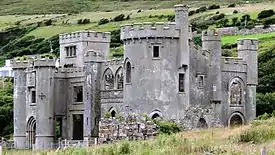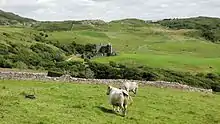Clifden Castle
Clifden Castle is a ruined manor house west of the town of Clifden in the Connemara region of County Galway, Ireland. It was built c. 1818 for John D'Arcy, the local landowner, in the Gothic Revival style.[1]:130 Uninhabited after 1894 it fell into disrepair. In 1935, ownership passed to a group of tenants, who were to own it jointly, and it quickly became a ruin.
| Clifden Castle | |
|---|---|
 Clifden Castle | |
 Location within Ireland | |
| General information | |
| Location | Clifden, County Galway, Ireland |
| Coordinates | 53.49178°N 10.05673°W |
| Construction started | around 1815 |
| Completed | c. 1818 |
| Client | John D'Arcy |
History
John D'Arcy (1785–1839), founder of Clifden, had this house constructed for himself and his family even while he was busy building up the town. The Castle dates from around 1818 and served as the main dwelling of the large D'Arcy family for the next decades. The land surrounding it was among the first drained and reclaimed in the Clifden area by D'Arcy.
In 1839, John D'Arcy died and his oldest son, Hyacinth, inherited the estate. However, Hyacinth (1806?–1874) was not as adept as his father at running the family properties and at dealing with his tenants. More disastrously, in 1845 the famine struck. Hunger, starvation and fever incapacitated large numbers of people as the potato crop failed. In desperation, many emigrated. As a consequence, rent income of the D'Arcy's plunged.[1]:11–15 On 21 September 1846, Hyacinth D'Arcy's tenants gathered en masse on his front lawn, begging for work or food.[1]:130
In the end, the D'Arcy estate went bankrupt and Clifden was one of several D'Arcy properties put up for sale on 18 November 1850.[1]:15 Thomas and Charles Eyre, brothers from Bath, bought the Castle, most of the town and surrounding lands for 21,245 pounds.[1]:15 They had been the mortgagees of the estate since 1837, shortly before John D'Arcy's death.[2]
The Eyre family used the Castle as a holiday home.[3] In the 1850s, a new roof was added and the facade altered to suit the taste of the new owners.[1]:130 Thomas Eyre eventually bought Charles' share and on 16 July 1864, two years before his own death,[4] gave the Castle and the Clifden estates as a present to his nephew, John Joseph Eyre of Saint John's Wood, London.[1]:15
The Eyre family were absentee landlords, but used Clifden Castle through John Joseph's death on 15 April 1894.[1]:130[3] After his death, a trust was set up to administer his estate,[4] which included considerable holdings in Britain and elsewhere.[1]:130 The trust ran the estates and John Joseph's six children and their descendants received the income from them. There was no individual owner of the Demesne after 1894, running the Clifden estate was left to agents. The Castle fell into disrepair, the Demesne was leased out for grazing to locals as attempts by the agents to sell the property were unsuccessful.[1]:166 All lands except the Demesne were eventually purchased by the Congested Districts Board or later the Land Commission.[1]:130

In 1917, J.B. Joyce, a local butcher, purchased the Castle and its lands. However, this sale resulted in great controversy. The Demesne, or castle lands, of Clifden Castle was around 200 acres (81 ha).[1]:166 Numerous former tenants of small scale farms in the area who had purchased their holdings via the Congested Districts Board had coveted the land of the Clifden Demesne to expand their own farms. In 1913, the land was offered to the Congested Districts Board at the price of 2,100 pounds. The farmers were interested in the purchase, but no decision was made. Then in 1917, Joyce bought the land. The local Catholic priest, Canon Patrick McAlpine, started a "severe and sometimes violent"[1]:167 campaign against "the underhanded way" of the purchase. From the pulpit, McAlpine denounced Joyce as a 'land grabber' and said he "had passed the graves of grabbers and within six months he would pass the grave of the Clifden Grabber and there would be six feet of clay over him".[1]:167
The whole town of Clifden turned against Joyce, although Sinn Féin supported him. Farmers drove Joyce's cattle from his land, put their own stock on his fields and barricaded the gates against him. A town meeting on the issue resulted in a scuffle, stones thrown at the police and injured policemen.[1]:168–169 Legal action went on until January 1920, when the judge confirmed Joyce's ownership. However, the tenants did not accept that and his cattle were again driven off.
Only after a Sinn Féin arbitration court suggested an agreement in September 1920 did Joyce agree to sell the land. It was purchased for 2,300 pounds plus legal costs plus 150 pounds for damages by trustees who were to set up the 'Clifden Cooperative'. The agreement postulated that the wood and castle were to be 'preserved as the property of the Clifden people'.[1]:171
The cooperative was established in November 1921. Although it held the official title, in fact the tenants divided up the land among themselves. In May 1935, the Land Commission purchased the land from the Cooperative and passed on ownership of Clifden Castle to the tenants, to be held jointly. The contents of the house had been previously auctioned off, but now the roof, windows, timber and lead were stripped away. Without a roof, Clifden Castle soon fell into ruin.[1]:171
Architecture


The estate faces south and overlooks Clifden Bay. It was constructed in the Gothic Revival style, popular in the early 1800s. The Castle's original features include a rounded tower to the southeast, a square tower and an entry tower with two round turrets.[3] However, most current decorative features date from the 1850s/1860s and were added by the Eyre family.[3]
The estate also includes a large gateway, built in 1815 in the medieval style.[5] In addition, D'Arcy had several standing stones erected on his property, four remain along the winding path between the gateway and the house. One of them might be a prehistoric worked stone, originating from elsewhere.[3][6]
To the west of the Castle, a substantial enclosed farmyard was constructed. This comprised a grain store, workers' cottages, stable and coachhouse. Next to it was a walled garden, with a well and pond nearby.[7] On the Demesne there are also the remains of a 'marine temple' made of sea shells on the stream to the east of the Castle.[6] Close to the road to the north is a children's graveyard, originally for three Eyre children who died in the 1880s.[6]
Today
The former Demesne and Castle are now owned by several families.[3] The gateway is visible from the Sky Road, and access to the Castle is through the gateway along a path that meanders across the hillside to the Castle. The surrounding grassland is populated by grazing cows, sheep and horses, and part of the castle ruins is a cow pen.
References
- Villiers-Tuthill, Kathleen (2006). Beyond the Twelve Bens – a history of Clifden and district 1860–1923. Connemara Girl Publications. ISBN 978-0-9530455-1-8.
- "Landed estates database: D'Arcy (Kiltullagh & Clifden Castle)". NUI Galway. Retrieved 31 January 2013.
- "National Inventory of Architectural Heritage: Clifden Castle Main Building". Retrieved 31 January 2013.
- "Landed estates database: Eyre (Clifden)". NUI Galway. Retrieved 31 January 2013.
- "National Inventory of Architectural Heritage: Clifden Castle gateway". Retrieved 31 January 2013.
- Robinson, Tim (2005). Connemara. Part 1: Introduction and gazetteer. Folding Landscapes, Roundstone. p. 47. ISBN 0-9504002-5-4.
- "National Inventory of Architectural Heritage: Clifden Castle enclosed farmyard". Retrieved 31 January 2013.
Further reading
- Villiers-Tuthill, Kathleen (1982). History of Clifden 1810–1860. self-published. ASIN B0006DKE4S.
